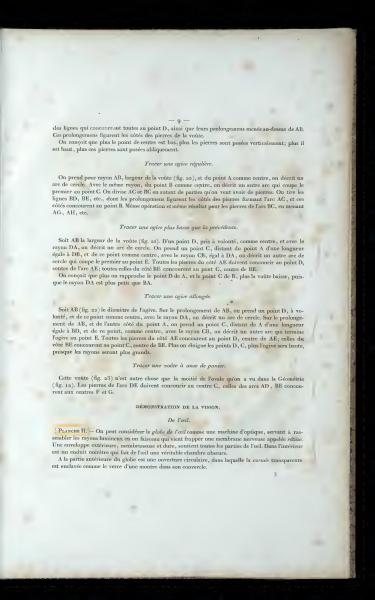The page provides instructions for drawing different types of arches and their formations, including regular, lower, elongated, and basket-handle arches, using points and radii as guides. It also includes a brief demonstration of vision, describing the eye as an optical machine that collects light to strike the retina, likened to a camera obscura.
— 9 —
These lines all converge at point D, and their extensions are drawn above AB. These extensions represent the sides of the stones of the arch. It can be understood that the lower the center point is, the more the stones are placed vertically; the higher, the more they are placed obliquely.
Drawing a Regular Arch.
Take AB as the radius, the width of the arch (fig. 20), and from point A as the center, describe an arc of a circle. With the same radius, from point B as the center, describe another arc that intersects the first at point C. Divide AC and BC into as many parts as stones desired. Draw lines BD, BE, etc., whose extensions represent the sides of the stones forming the arc AC, and these sides converge at point B. Perform the same operation and achieve the same results for the stones of arc BC, by drawing AG, AH, etc.
Drawing an Arch Lower than the Previous One.
Let AB be the width of the arch (fig. 21). From a chosen point D as a center, and with the radius DA, describe an arc of a circle. Take a point C, distant from point A by a length equal to DB, and from this point as the center, with the radius CB, equal to DA, describe another arc that intersects the first one at point E. All stones on side AE must converge at point D, center of arc AE; all those on side BE converge at point C, center of BE. Understand that the closer point D is to A, and point C is to B, the lower the arch drops, since the radius DA is smaller than BA.
Drawing an Elongated Arch.
Let AB (fig. 22) be the diameter of the arch. On the extension of AB, choose a point D, at will, and from this point as the center, with radius DA, describe an arc of a circle. On the extension of AB, on the other side of point A, take a point C, distant from A by a length equal to BD, and from this point as the center, with radius CB, describe another arc concluding the arch at point E. All stones on side AE converge at point D, center of AE; those on side BE converge at point C, center of BE. The farther the points D, C are removed, the higher the arch will be, since the radii are larger.
Drawing a Basket Handle Arch.
This arch (fig. 23) is nothing but half of the oval seen in Geometry (fig. 12). The stones of arc DE must converge at center C, those of arcs AD, BE converge at centers F and G.
Demonstration of Vision.
On the Eye.
Planche II. The eyeball can be considered as an optical machine, serving to gather light rays into a beam that strikes a nerve membrane called the retina. An outer, membranous, and hard envelope supports all parts of the eye. Inside is a dark coating that makes the eye a true camera obscura. At the front of the globe is a circular opening, in which the transparent cornea is embedded like the glass of a watch in its case.
3
